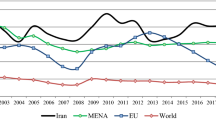Abstract
The paper investigates Scandinavian countries and their male and female unemployment rates. Okun’s law is used to estimate age cohort and gender-specific Okun coefficients to make inference about the business-cycle dependence of young peoples’ unemployment across Scandinavian countries. Results show that men have higher Okun coefficients in absolute terms. Thus, their unemployment rate reacts more strongly to any change in GDP.





Similar content being viewed by others
Notes
EU15 includes all countries that were members of the EU before the eastern enlargement in May 2004. A more detailed and country-specific analysis of major EU15 countries is found in Hutengs and Stadtmann (2013).
Unemployment rates are based on International Labour Organisation (ILO) standards, ensuring comparability among different countries.
The end date (2011) is determined by data availability at the time of the study. Countries included in the study with number of observations per cohort: Denmark, Finland, Norway, Sweden, EU15 (28 years) and Iceland (22 years).
Estimation results are obtained through linear regression with Prais-Winsten standard errors.
Significance test results are available from the authors on request.
Own calculations based on Eurostat data: Employment by sex, age and economic activity (from 2008 onwards, NACE Rev. 2) – 1000 [lfsa_egan2]. See Signorelli et al. (2012) for a discussion about the impact of crises on females.
References
Bell, DNF and Blanchflower, DG . 2011: Youth unemployment in Europe and the United States. Nordic Economic Policy Review 1: 11–37.
Brenke, K . 2012: Arbeitslosigkeit in Europa: Jugendliche sind viel starker betroffen als Erwachsene. Wochenbericht des DIW Berlin 30: 3–12.
Cevik, EI, Dibooglu, S and Barisik, S . 2013: Asymmetry in the unemployment–output relationship over the business cycle: Evidence from transition economies. Comparative Economic Studies 55 (4): 557–581.
European Commission. 2013: The impact of the economic crisis on the situation of women and men and on gender equality policies. Publications Office of the European Union: Luxembourg.
European Economic Advisory Group. 2013: The EEAG report on the European economy. CESifo: Munich.
Eurostat. 2014: The Labour Force Survey (LFS) – Detailed Annual Survey Results. Eurostat Employment and Unemployment (LFS) Statistical Database, accessed 12 May 2014.
Freeman, DG . 2001: Panel tests of Okun’s law for ten industrial countries. Economic Inquiry 39 (4): 511–523.
Hutengs, O and Stadtmann, G . 2013: Age effects in Okun’s law within the Eurozone. Applied Economics Letters 20 (9): 821–825.
Hutengs, O and Stadtmann, G . 2014: Don’t trust anybody over 30: Youth unemployment and Okun’s law in CEE countries. Bank i Kredyt 45 (1): 1–16.
Knoester, A . 1986: Okun’s law revisited. Weltwirtschaftliches Archiv 122 (4): 657–666.
Knotek, ES . 2007: How useful is Okun’s law? Economic Review, Federal Reserve Bank of Kansas City Q IV: 73–103.
Korpi, T and Mertens, A . 2003: Training systems and labor mobility: A comparison between Germany and Sweden. The Scandinavian Journal of Economics 105 (4): 597–617.
Lee, J . 2000: The robustness of Okun’s law: Evidence from OECD countries. Journal of Macroeconomics 22 (2): 331–356.
Moosa, IA . 1997: A cross-country comparison of Okun’s coefficient. Journal of Comparative Economics 24 (3): 335–356.
OECD. 2010: Off to a good start? Jobs for youth. OECD Publishing: Paris.
OECD. 2013: Labour Force Statistics: Population and labour force. OECD Employment and Labour Market Statistics (database), accessed 14 January 2013, doi: 10.1787/lfs-lfs-data-en.
O’Higgins, N . 2003: Trends in the youth labour market in developing and transition countries. World Bank Social Protection Discussion Paper Series 0321, http://go.worldbank.org/XTNM664DJ2.
Okun, AM . 1962: Potential GNP: Its measurement and significance. In: Baily, MN and Okun, AM (eds). The Battle Against Unemployment and Inflation (1982). Norton: New York, 132–145.
Olofsson, J and Wadensjo, E . 2012: Youth, education and labour market in the Nordic countries. Friedrich-Ebert-Stiftung, International Dialogue, http://library.fes.de/pdf-files/id/09468.pdf.
Ryan, P . 2001: The school-to-work transition: A cross-national perspective. Journal of Economic Literature 39 (1): 34–92.
Signorelli, M, Choudhry, M and Marelli, E . 2012: The impact of financial crises on female labour. European Journal of Development Research 24 (3): 413–433.
Sogner, L and Stiassny, A . 2002: An analysis on the structural stability of Okun’s law–A cross-country study. Applied Economics 34 (14): 1775–1787.
Author information
Authors and Affiliations
Rights and permissions
About this article
Cite this article
Hutengs, O., Stadtmann, G. Age- and Gender-Specific Unemployment in Scandinavian Countries: An Analysis based on Okun’s Law. Comp Econ Stud 56, 567–580 (2014). https://doi.org/10.1057/ces.2014.22
Published:
Issue Date:
DOI: https://doi.org/10.1057/ces.2014.22




